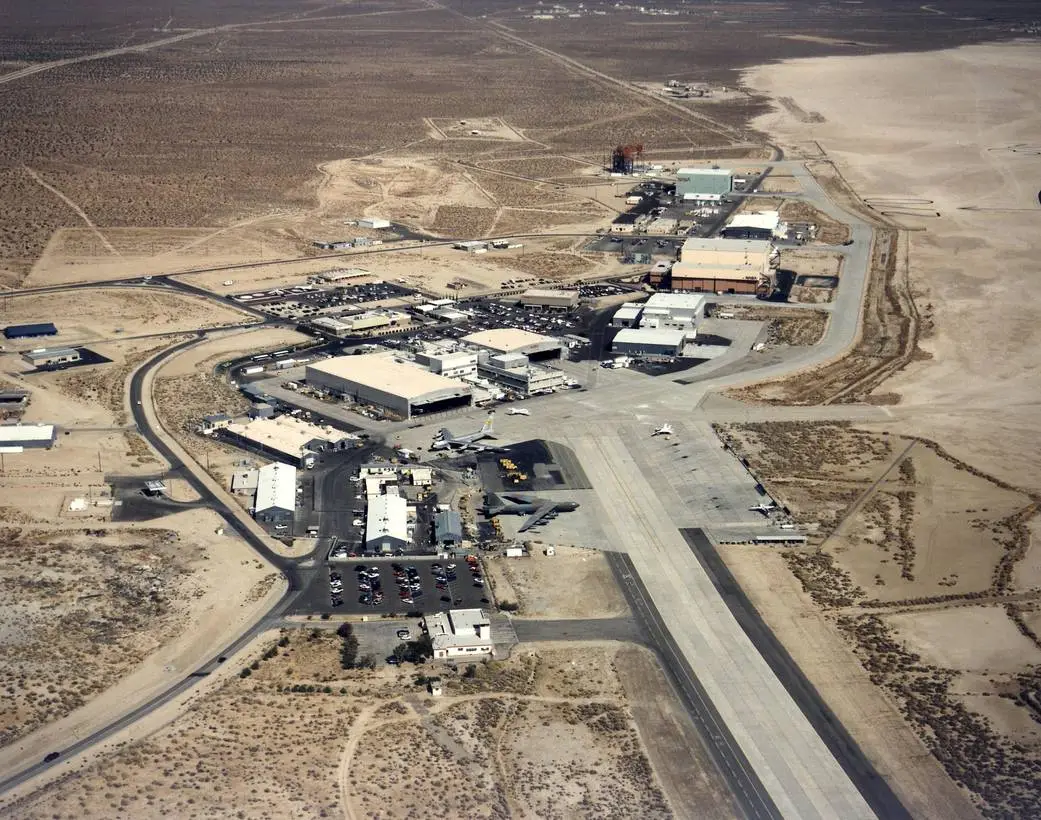The “Flight Test Files” series of articles explores the aircraft used by the Dryden Flight Research Center over the years in its pursuit of aeronautical advancements. Since the 1940s, the Dryden Flight Research Center in Edwards, CA, has built a unique and specialized capability for conducting flight research programs. This organization, composed of pilots, scientists, engineers, technicians, mechanics, and administrative professionals, has been and continues to be a leader in the field of advanced aeronautics. Located on the northwest edge of Rogers Dry Lake, the complex was originally centered around the administrative hangar building constructed in 1954. Over time, additional support and operational facilities have been added, including unique test facilities like the Thermalstructures Research Facility, Flow Visualization Facility, and Integrated Test Facility. One of the most notable structures is the space shuttle program’s Mate-Demate Device and hangar, located in Area A to the north of the main complex. The lakebed surface also features a Compass Rose, providing pilots with an instant compass heading. The Dryden complex originated at Edwards Air Force Base to support the X-1 supersonic flight program. As other high-speed aircraft entered research programs, the facility became permanent, expanding from a staff of five engineers in 1947 to nearly 1,100 full-time government and contractor employees by 2006.
A-5A Vigilante
There has long been a close aerospace research partnership between NASA (and it’s forebear, the N.A.C.A.) and the U.S. military. This association is perhaps best exemplified by their co-located facilities in California’s Mojave Desert centered around what was once known as Muroc Dry Lake Bed (now known as Rogers Dry Lake) an ancient, long-evaporated lake, with an extremely flat and hard-packed floor; it was perfect terrain for a natural runway of extreme length. Muroc was where many of America’s first experimental jet and rocket planes took flight, including the Bell XS-1, the rocket-plane which first broke the speed of sound back in October, 1947. Back then, most people simply referred to the place as Muroc… it was a deeply inhospitable location; arid, dusty, and bleached incessantly by the searing heat of the sun during much of the year (and icy cold without it). There were no amenities to speak of either, during those early days, so no one but the hardiest and most daring of pilots would want a posting to Muroc. Today, of course, the facility is encompassed within the massive Edwards Air Force Base, the world’s premiere aerospace testing facility. As intimated earlier, NASA has a strong presence at Edwards AFB. It’s Armstrong Flight Research Center has a fleet of diverse airframes, many of them on bailment from the U.S. military, to conduct a variety of research aims, for both civilian and military-oriented cutting-edge projects.
The Armstrong Flight Research Center has had many names over the years, starting out as the N.A.C.A. Muroc Flight Test Unit in 1946. The facility only gained its current name in 2014, a year or so after the legendary NASA astronaut, Neil Armstrong’s death, but for the previous two decades, the world knew NASA’s Mojave Desert ‘paradise’ as the Dryden Flight Research Center, named after an earlier NASA/N.A.C.A. great, Hugh Dryden. So many fascinating projects took place here over the years that we thought our readers might occasionally enjoy learning about some of them. We thought we’d name this series Flight Test Files, to repflect NACA/NASA programs.
One such project involved North American Aviation’s A-5 Vigilante the U.S. Navy’s first carrier-borne supersonic nuclear bomber…
A North American Aviation A-5A Vigilante jet aircraft was used for simulation studies regarding a proposed supersonic transport in 1963. These flights followed two flight plans based upon earlier NASA Flight Research Center studies, one for a variable-sweep wing configuration and the other for a delta-wing configuration. NASA Flight Research Center test pilot William H. Dana made approximately 21 flights along federal airways that entered Los Angeles.
North American Aviation A-5A Vigilante (Navy serial number 147858/NASA tail number 858) arrived from the Naval Air Test Center, Patuxent River, MD, on December 19, 1962, at the NASA Flight Research Center (now, Dryden Flight Research Center, Edwards, CA). The Center flew the A-5A in a year-long series of flights in support of the U.S. supersonic transport program. The Center flew the aircraft to determine the let-down and approach conditions of a supersonic transport flying into a dense air traffic network. With the completion of the research flights, the Center sent the A-5A back to the Navy on December 20, 1963.
Photos and historical information by Armstrong Flight Research Center































